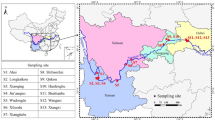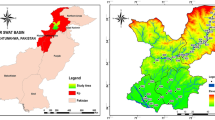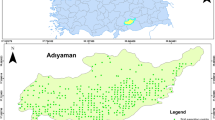Abstract
The distribution, potential ecological hazards, and homologous relativity of heavy metals in the water-level fluctuating zone (WLFZ) of the Yangtze River within the Wanzhou Section (YRWS) were investigated. The heavy metal content (Cd, Cu, Cr, and Ni) of the surface soil was analysed via atomic absorption spectroscopy. The potential ecological hazards of the heavy metals in the WLFZ soil of YRWS were also evaluated using the classical Lars Hakanson potential ecological risk index method, and the relevance of the heavy metals in the soil was investigated. The average Cd, Cr, Cu, and Ni concentrations were 2.14, 35.43, 18.47, and 34.52 mg/kg, respectively. The Cd and Ni contents in the soil exceeded the reference values in China by about 28.6- and 1.1-fold, respectively. Correlation analysis shows a highly significant correlation between Cd and Cr, indicating that their sources were the same. The major pollutant was Cd, which reached a very strong ecological hazard level. The potential ecological risk individual coefficients of the four heavy metals were ranked as follows: Cd (802.61) > Cu (4.43) > Ni (4.15) > Cr (1.23). The risk levels in the different regions were ranked as follows: Zhuxi River > mainstream > Mixi valley. The potential ecological risk in the WLFZ within the Zhuxi River was the highest among the regions and poses a certain health risk.

Similar content being viewed by others
References
Bai SB, Wang J, Lü GN, Zhou PG, Hou SS, Xu SN (2010) GIS-based logistic regression for landslide susceptibility mapping of the Zhongxian segment in the Three Gorges area, China. Geomorphology 115:23–31
Zhang J, Zhengjun L, Xiaoxia S (2009) Changing landscape in the Three Gorges Reservoir Area of Yangtze River from 1977 to 2005: land use/land cover, vegetation cover changes estimated using multi-source satellite data. Int J Appl Earth Obs Geoinf 11:403–412
Fu C, Guo J, Pan J, Qi J, Zhou W (2009) Potential ecological risk assessment of heavy metal pollution in sediments of the Yangtze River within the Wanzhou Section, China. Biol Trace Elem Res 129:270–277
Muller B, Berg M, Yao ZP, Zhang XF, Wang D, Pfluger A (2008) How polluted is the Yangtze river? Water quality downstream from the Three Gorges Dam. Sci Total Environ 402:232–247
Qin YY, Leung CKM, Leung A, Wu SC, Zheng JS, Wong MH (2010) Persistent organic pollutants and heavy metals in adipose tissues of patients with uterine leiomyomas and the association of these pollutants with seafood diet, BMI, and age. Environ Sci Pollut Res 17:229–240
Kumar Sharma R, Agrawal M, Marshall F (2007) Heavy metal contamination of soil and vegetables in suburban areas of Varanasi, India. Ecotoxicol Environ Safety 66:258–266
Zhang W, Feng H, Chang J, Qu J, Xie H, Yu L (2009) Heavy metal contamination in surface sediments of Yangtze River intertidal zone: an assessment from different indexes. Environ Pollut 157:1533–1543
Doong R, Lee S, Lee C, Sun Y, Wu S (2008) Characterization and composition of heavy metals and persistent organic pollutants in water and estuarine sediments from Gao-ping River, Taiwan. Mar Pollut Bull 57:846–857
Mansour SA, Belal MH, Abou-Arab AAK, Gad MF (2009) Monitoring of pesticides and heavy metals in cucumber fruits produced from different farming systems. Chemosphere 75:601–609
Wu W, Xie DT, Liu HB (2009) Spatial variability of soil heavy metals in the three gorges area: multivariate and geostatistical analyses. Environ Monit Assess 157:63–71
Sun Y, Zhou Q, Xie X, Liu R (2010) Spatial, sources and risk assessment of heavy metal contamination of urban soils in typical regions of Shenyang, China. J Hazard Mater 174:455–462
Wang W, Massey Simonich SL, Xue M, Zhao J, Zhang N, Wang R, Cao J, Tao S (2010) Concentrations, sources and spatial distribution of polycyclic aromatic hydrocarbons in soils from Beijing, Tianjin and surrounding areas, North China. Environ Pollut 158:1245–1251
Hakanson L (1980) An ecological risk index for aquatic pollution control. A sedimentological approach. Water Res 14:975–1001
Liu J, Li Y, Zhang B, Cao J, Cao Z, Domagalski J (2009) Ecological risk of heavy metals in sediments of the Luan River source water. Ecotoxicology 18:748–758
CEPA (1990) Elemental background values of soils in China. Environ Sci Press of China, Beijing
Li S, Zhang Q (2010) Spatial characterization of dissolved trace elements and heavy metals in the upper Han River (China) using multivariate statistical techniques. J Hazard Mater 176:579–588
Chen T, Liu X, Zhu M, Zhao K, Wu J, Xu J, Huang P (2008) Identification of trace element sources and associated risk assessment in vegetable soils of the urban-rural transitional area of Hangzhou, China. Environl Pollut 151:67–78
Khan S, Cao Q, Zheng YM, Huang YZ, Zhu YG (2008) Health risks of heavy metals in contaminated soils and food crops irrigated with wastewater in Beijing, China. Environ Pollut 152:686–692
Dragovic S, Mihailovic N, Gajic B (2008) Heavy metals in soils: distribution, relationship with soil characteristics and radionuclides and multivariate assessment of contamination sources. Chemosphere 72:491–495
De Wolf H, Rashid R (2008) Heavy metal accumulation in Littoraria scabra along polluted and pristine mangrove areas of Tanzania. Environ Pollut 152:636–643
Terzano R, Spagnuolo M, Vekemans B, De Nolf W, Janssens K, Falkenberg G, Fiore S, Ruggiero P (2007) Assessing the origin and fate of Cr, Ni, Cu, Zn, Pb, and V in industrial polluted soil by combined microspectroscopic techniques and bulk extraction methods. Environ Sci Technol 41:6762–6769
Acknowledgements
This research was supported by the Construction of Research and Innovation Teams of the Educational Commission of Chongqing, China (no. 2010-16), and the Key Project of Chongqing Three Gorges University (contract no. 10ZD-15).
Author information
Authors and Affiliations
Corresponding author
Rights and permissions
About this article
Cite this article
Lin, J., Fu, C., Zhang, X. et al. Heavy Metal Contamination in the Water-Level Fluctuating Zone of the Yangtze River within Wanzhou Section, China. Biol Trace Elem Res 145, 268–272 (2012). https://doi.org/10.1007/s12011-011-9179-6
Received:
Accepted:
Published:
Issue Date:
DOI: https://doi.org/10.1007/s12011-011-9179-6




